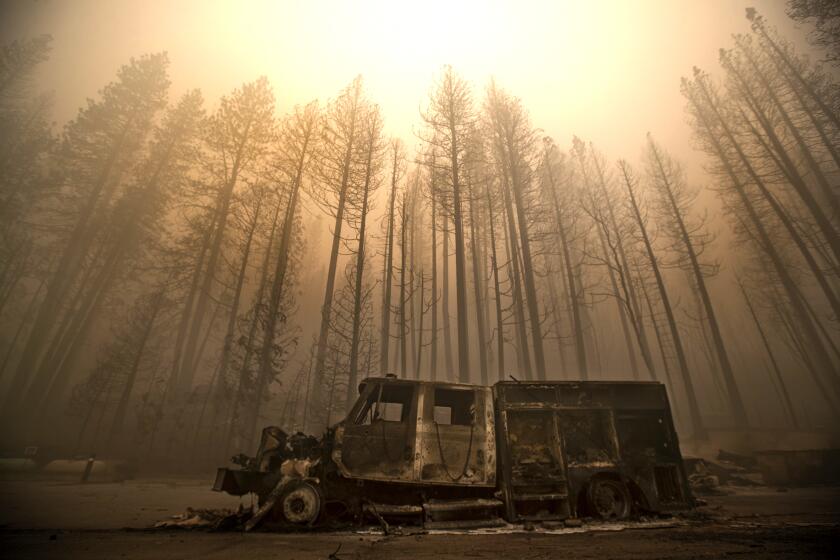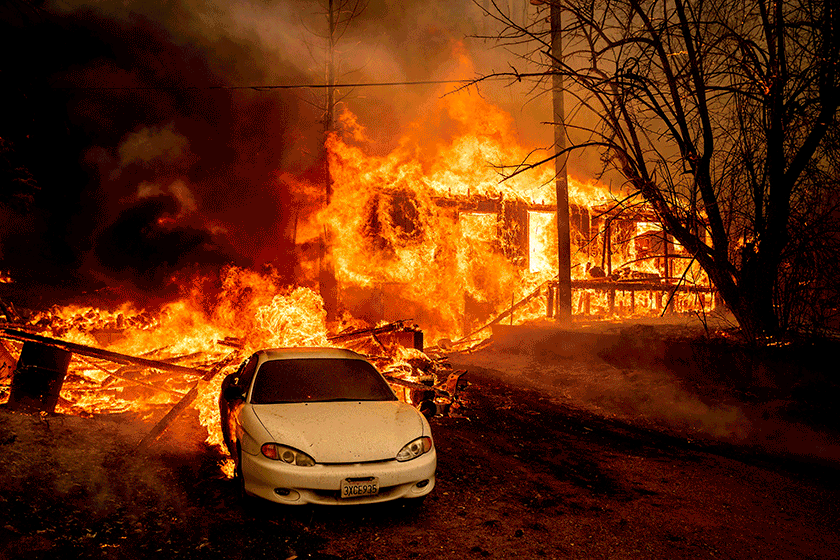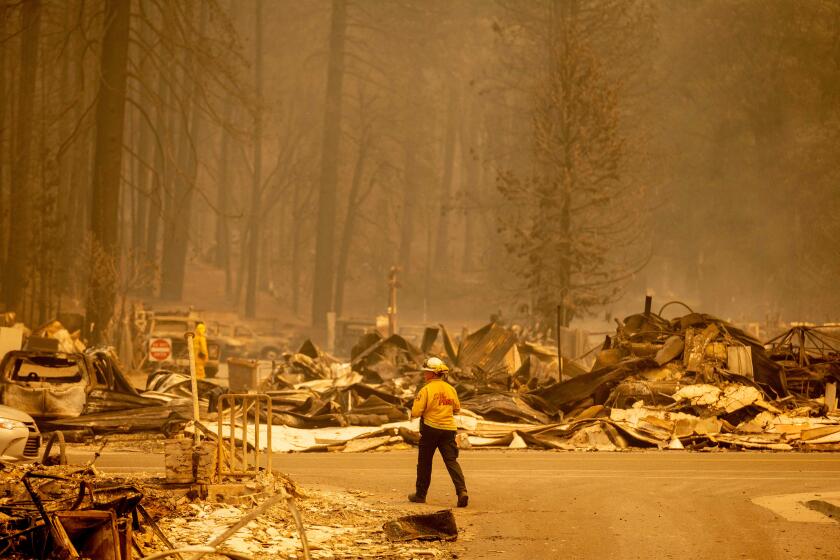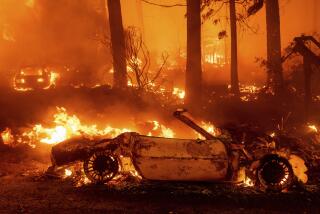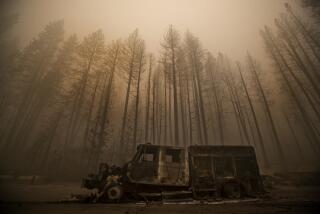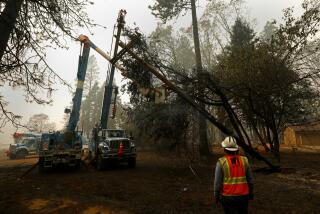PG&E power line suspected in Dixie fire was set to be buried underground in safety move
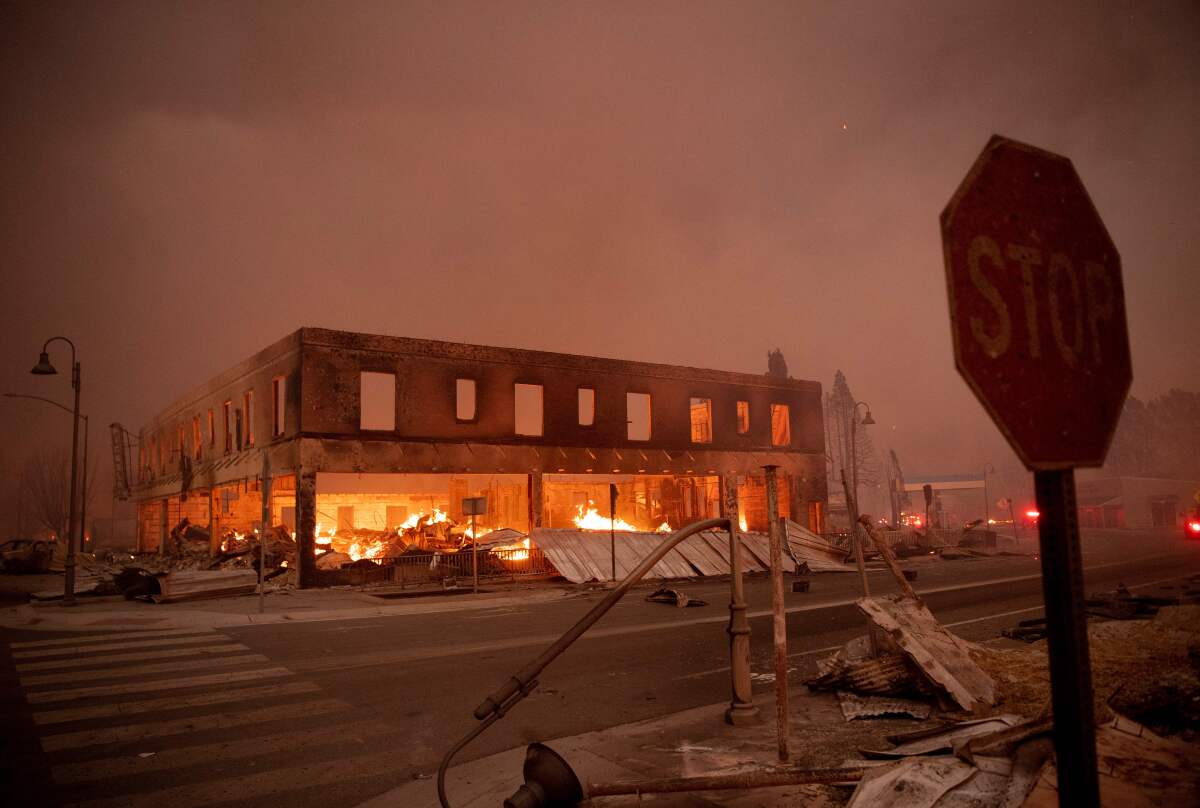
After Pacific Gas & Electric equipment sparked a massive fire that burned much of Paradise, Calif., and killed 86 people in 2018, the utility vowed a safety campaign aimed at preventing similar disasters.
PG&E said it would bury some power lines snaking through Northern California forest land, significantly reducing the risk of wildfires caused when winds damage equipment. Among the power lines set to be buried was a 10-mile stretch that may have started this year’s destructive Dixie fire, now the second largest in California history.
For the record:
9:19 a.m. Aug. 11, 2021An earlier version of this article said the U.S. Forest Service approved the line burial project in July 2020 and the California Department of Transportation granted a permit in October. Those approvals were for work on a different section of the line.
The situation underscores the rising scrutiny PG&E is facing this summer as a string of huge fires across Northern California have raged amid hot, dry conditions. PG&E power lines might have been responsible for at least three of those fires, according to documents the utility has filed with state regulators and a federal court. Legal liability from the devastation in Paradise and other wildfires pushed PG&E into bankruptcy and brought vows that the utility would fix its power grid. But the new fires have brought new outrage and demonstrate that there is still much work to do.
The Dixie fire has now burned more than 480,000 acres in four counties, destroying over 400 homes and commercial buildings
Early in the week, the Dixie fire continued to grow and the River fire burned homes north of Sacramento.
The line burial project remains in progress, with no estimated completion date, said James Noonan, spokesman for PG&E.
“This project will require CalTrans and other governmental agency permits, FERC review, and other land/environmental dependencies,” Noonan wrote in an email (FERC is the Federal Energy Regulatory Commission). “The final completion date for this project is dependent upon the timely fulfilment of these various requirements.”
PG&E’s Wildfire Risk Governance Steering Committee had approved the work in January after considering public safety power shutoff decisions, ingress and egress issues, and tree-fall risk along the power line, which was considered moderate, Noonan said.
“We are taking steps every day to improve the safety and reliability of our electric system,” Noonan wrote. “This includes working with customers and communities to manage trees and other vegetation located near power lines that could cause a wildfire or power outage.”
On July 13, a Douglas fir fell onto the line, and two fuses were blown, according to documents PG&E filed in federal court. In the filings, the utility described a series of mishaps and delays that resulted in an employee not reaching the site until about 10 hours later, by which time a 600- to 800-square-foot fire had ignited.
One challenge for fire crews in Plumas County is residents who won’t leave their property, forcing firefighters to take risks on their behalf.
Before the fire, there were no issues with the equipment on the span of line that had been identified but not fixed, nor were there trees that had been targeted for trimming or removal on which the work hadn’t yet been performed, Noonan said. A vegetation management inspection took place Jan. 14 but did not flag the tree that’s believed to have fallen on the line as needing work, he said.
PG&E had also inspected the two poles between which the tree was found leaning May 13 and found nothing that required corrective action, Noonan said.
Nine days after the Dixie fire started, PG&E equipment might have ignited the Fly fire nearly 30 miles to the northeast — disturbances were recorded on a circuit around the same time the fire broke out, and a tree was later found resting on a conductor, the utility said in a report filed with the California Public Utilities Commission. That fire grew to more than 4,300 acres before merging with the Dixie fire, which on Sunday leapfrogged the 2018 Mendocino Complex fire to become the second largest in California history.
District attorneys in two counties — Butte and Plumas — are investigating PG&E for potential criminal liability in the fire.
“It’s literally torn our county in two,” said Plumas County Dist. Atty. David Hollister, who has partnered with the office of Butte County Dist. Atty. Mike Ramsey and the California Department of Forestry and Fire Protection to conduct the investigation. “We’ve lost most of the northern part of our county.”
Investigators have visited the origin sites of both the Dixie and Fly fires to gather PG&E equipment and trees that might have fallen into the lines for a forensic examination, Ramsey said. They are examining whether adequate vegetation management was done there and whether equipment was maintained, as well as the amount of time it took the utility to realize there was a problem with the line after a disturbance was recorded, he said.
“As we all know, that canyon where the Camp fire started is extraordinarily dry,” Ramsey said. “We know; they should know.”
The Dixie fire started in the same canyon, he noted.
Ramsey’s office previously secured a deal in which PG&E pleaded guilty to 84 counts of manslaughter and one count of reckless arson in connection with the Camp fire, which destroyed the town of Paradise. The utility received the maximum fine of $3.5 million, which Ramsey called “woefully underwhelming.”
“But more important was the fact that they were held responsible for the first time for killing folks,” he said, noting that PG&E had been previously prosecuted for regulatory violations when its equipment caused deaths.
Although no deaths have yet been reported in the Dixie fire, prosecutors are exploring other avenues as well, they said, noting that Section 452 of the California Penal Code sets forth crimes concerning reckless burning.
But with the fire just 21% contained and authorities still scrambling to make sure everyone is safe, it remains early in the investigation.
Greenville, a Gold Rush town dating to the 19th century, rebuilt after an 1881 fire. Now it has been destroyed by the Dixie fire, California’s largest this year.
Tehama County Dist. Atty. Matthew Rogers said his office is not investigating PG&E at this time. Lassen County Dist. Atty. Susan Rios said she may ask to join the investigation later if the county sustains losses attributable to the fire but noted that there hasn’t been a damage assessment conducted there yet.
“They’re just trying to save lives and save towns,” said Rios, whose own home remained under an evacuation warning Monday.
The events come as the latest blow to the beleaguered utility, which is also facing a criminal investigation for its role in sparking last year’s Zogg fire. That fire killed four people, destroyed more than 200 homes and burned 56,000 acres.
In addition, a federal judge last week ordered PG&E to explain its role in potentially igniting the Fly fire, and to provide more information about the Dixie fire, including drone video taken the day it ignited.
A drone seen flying over the fire in the hours after it started is rumored to have been operated by PG&E or one of its contractors, Ramsey said. The sighting grounded firefighting aircraft for the evening, he said.
“The air assets had it pretty well blocked in with retardant at less than one or two acres,” Ramsey said. “The drone showed up, and those air assets had to be taken out, and that night it burned through the retardant lines. And now we have the monster that we have.”
Records show that all the drones authorized to fly on PG&E’s behalf on July 13 in Butte or Plumas counties had completed their flights by about 12:30 p.m., Noonan said.
U.S. District Judge William Alsup, who is overseeing the utility’s criminal probation stemming from an explosion of one of its Bay Area gas lines that killed eight people in 2010, also ordered PG&E to provide a list by Aug. 16 of all fires its equipment has started this season.
The utility has already disclosed that its equipment might have ignited a third fire: the Bader fire, which burned a quarter-acre in Magalia on July 14. One stem of a two-stemmed black oak was found leaning on a power line that had snapped, according to court documents.
And in April, Sonoma County Dist. Atty. Jill Ravitch charged PG&E with five felony and 28 misdemeanor counts over its role in the Kincade fire, which badly injured six firefighters in 2019.
PG&E is an investor-owned utility that is overseen by the California Public Utilities Commission. It is required to make certain disclosures as a result of its criminal probation, as well as a 2018 law passed by the state Legislature that requires utilities to submit annual plans to mitigate the risk of wildfire in their service territories and file quarterly updates on their progress.
PG&E has consistently failed to meet targets it has committed to in those disclosures for things like vegetation management and equipment inspections, advocates say.
“The challenge is that every time we see a third-party inspection report, either from the Public Utilities Commission or the federal court monitor, we see that over and over again, PG&E has failed to trim the vegetation in the highest fire risk zones like they were supposed to, that they failed to inspect all of their transmission towers and equipment they were supposed to,” said Mark Toney, executive director of the Utility Reform Network, a San Francisco-based consumer advocacy group. “It’s very concerning that we have so much money being spent and not the kind of results that people expect and deserve.”
The California Public Advocates Office, a consumer watchdog agency, identified so many deficiencies in PG&E’s wildfire mitigation plan this year that in June it submitted a response urging the PUC to issue a finding that the utility was no longer in good standing for the remainder of 2021.
Two years ago, the Legislature adopted a bill that includes a provision laying out a six-step process that will result in PG&E being converted from a private corporation to a quasi-public entity called Golden State Power if it is unable to meet safety standards. PG&E is currently at step one.
“The higher the PUC moves them up, the greater the chance that PG&E will cease to exist as we know it,” Toney said. “I wouldn’t be surprised to see the PUC looking at moving PG&E up that ladder, given the more recent events, particularly after Cal Fire issues its report.”
Public utilities differ from investor-owned utilities mainly in that they are not-for-profit so they’re beholden only to customers, said Barry Moline, executive director of the California Municipal Utilities Assn., a trade group for public utilities.
At the same time, he said, it’s important to note that just because PG&E’s equipment might have sparked a wildfire doesn’t mean the utility is necessarily at fault.
“While I think everybody is eager to jump on PG&E, I think that it’s really difficult to understand the exact circumstances without an investigation and trying to figure out what happened,” he said. “I believe that PG&E is highly focused on maintaining their system and doing what they can to minimize any ignition of a fire.”
Should it be unable to get a handle on wildfire mitigation, PG&E could also lose the confidence of its investors, in addition to potentially losing the franchise to provide power, Toney said.
“If they get further downgrades in their credit, and end up at junk bond status, it’s always possible they could end up in bankruptcy again,” he said. “That would be a terrible outcome for everyone involved, quite frankly.”
More to Read
Sign up for Essential California
The most important California stories and recommendations in your inbox every morning.
You may occasionally receive promotional content from the Los Angeles Times.
